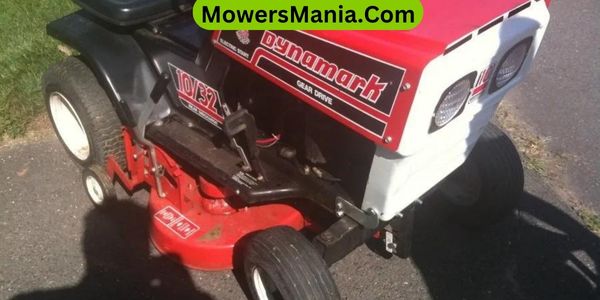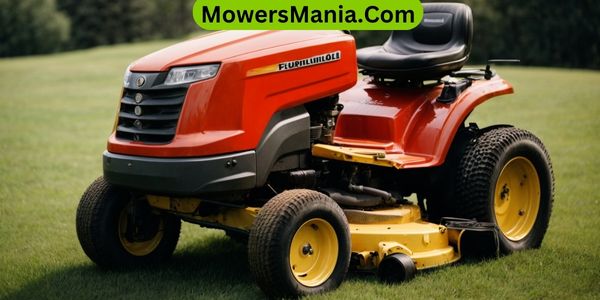Are you worried that your riding lawn mower’s engine might be seized? Don’t panic, because we’ve got you covered.
In this article, we’ll show you how to identify the telltale signs of a seized engine. From unusual noises and lack of power to engine resistance and starter failures, we’ll walk you through the indicators and help you diagnose the problem.

So, let’s get started and get your lawn mower back up and running smoothly again!
Unusual Engine Noise
Listen for any strange sounds coming from the engine of your riding lawn mower. Unusual engine noise can be an early indication that something is wrong. If you hear a knocking or banging sound, it could be a sign that the engine is seized.
This occurs when the internal components, such as the piston, cylinder, or crankshaft, become stuck and are no longer able to move freely.
Another noise to be aware of is a grinding or scraping sound, which may indicate that the engine has suffered serious damage.
This could be due to a lack of lubrication or worn-out parts. Additionally, if you hear a high-pitched squealing or whining noise, it could be a belt slipping or a problem with the pulleys.
Paying attention to these unusual sounds and addressing them promptly can help prevent further damage to your riding lawn mower’s engine.
If you notice any of these noises, it’s recommended to stop using the mower and have it inspected by a professional.
Lack of Power
If you notice a lack of power while operating your riding lawn mower, it could be a sign that the engine is experiencing issues.
Here are a few things to consider:
- Clogged air filter: A clogged air filter restricts the flow of air to the engine, resulting in decreased power output. Check the air filter and clean or replace it if necessary.
- Dirty fuel filter: A dirty fuel filter can obstruct the fuel flow to the engine, causing a reduction in power. Inspect the fuel filter and clean or replace it as needed.
- Worn spark plug: A worn or dirty spark plug can lead to inefficient combustion, resulting in a loss of power. Remove the spark plug and examine its condition. If it’s worn or covered in deposits, replace it with a new one.
Slipping drive belt: A slipping or worn drive belt can cause a lack of power transmission from the engine to the mower blades. Inspect the drive belt for signs of wear or looseness, and replace it if necessary.
Engine Resistance

To determine if your riding lawn mower engine is seized, pay attention to any noticeable resistance while operating the machine. Engine resistance refers to the difficulty or effort required to move the mower forward or backward.
When you engage the mower’s transmission and attempt to move, a seized engine will prevent the machine from moving smoothly. Instead, you may feel a sudden jerk or feel as if the mower is struggling to move.
This resistance can manifest in various ways, such as the mower stalling or refusing to start altogether. Additionally, you may notice a decrease in engine power or a grinding noise coming from the engine.
If you experience any of these symptoms, it’s essential to stop using the mower immediately to prevent further damage.
Ignoring engine resistance can lead to more severe issues, such as a completely seized engine, which may necessitate expensive repairs or even the need to replace the entire mower.
Therefore, it’s crucial to address engine resistance promptly to avoid costly repairs and ensure the longevity of your riding lawn mower.
Pull Cord or Electric Start Failure
When attempting to start your riding lawn mower engine, if you encounter difficulty with the pull cord or electric start, it’s crucial to investigate the cause.
There are several potential reasons why your pull cord or electric start may be failing:
- Faulty spark plug: A worn-out or dirty spark plug can prevent the engine from starting. Check and clean or replace the spark plug if necessary.
- Weak battery: If your riding mower has an electric start, a weak or dead battery could be the culprit. Ensure that the battery is fully charged and functioning properly.
- Fuel issues: Insufficient or contaminated fuel can cause starting problems. Check the fuel level and quality and make sure the fuel lines are clear of debris.
- Defective starter motor: If the electric start isn’t working, it could be due to a faulty starter motor. Inspect the starter motor for any signs of damage and consider replacing it if necessary.
Smoke or Burning Smell

When you notice smoke or a burning smell coming from your riding lawn mower engine, it’s crucial to address the issue promptly to avoid further damage.
Smoke or a burning smell can indicate a variety of problems within the engine. One possible cause is an oil leak. If oil is leaking onto hot engine parts, it can create smoke and a burning smell.
Another potential cause is a problem with the fuel system. If the fuel isn’t burning properly, it can result in smoke and a burning smell.
Additionally, a clogged air filter can cause the engine to overheat, leading to smoke and a burning odor.
Ignoring these signs can lead to more serious issues, such as engine failure or a fire hazard.
To address the problem, first, turn off the engine and allow it to cool down. Then, inspect the engine for any visible signs of oil leaks or damage. Check the air filter and clean or replace it if necessary.
If the issue persists, it’s recommended to consult a professional for further diagnosis and repair.
Frequently Asked Questions [FAQs]
Can a Riding Lawn Mower Engine Be Seized if It Is Making Unusual Engine Noise?
If your riding lawn mower engine is making unusual engine noise, it could be a sign that it is seized. In such cases, it is important to address the issue promptly to prevent further damage.
What Are Some Common Causes of Lack of Power in a Riding Lawn Mower Engine?
If your riding lawn mower engine lacks power, there could be a few common causes. Check the fuel system, spark plug, air filter, and carburetor. Also, ensure the blades are sharp and the drive belt is in good condition.
Is Engine Resistance a Common Issue in Riding Lawn Mower Engines, and How Can It Be Resolved?
Engine resistance can be a common issue with riding lawn mower engines. To resolve it, you should check the fuel and air filters, clean the carburetor, and ensure proper spark plug function.
What Are the Possible Reasons for Pull Cord or Electric Start Failure in a Riding Lawn Mower Engine?
If your riding lawn mower’s pull cord or electric start fails, there could be a few reasons. It could be due to a faulty starter motor, a dead battery, or a problem with the ignition switch.
Can a Riding Lawn Mower Engine Be Seized if There Is Smoke or a Burning Smell Coming From It?
If you notice smoke or a burning smell coming from your riding lawn mower engine, it could be a sign that the engine is seized. It’s important to address this issue promptly to prevent further damage.
Conclusion
In conclusion, if you notice unusual engine noise, lack of power, engine resistance, pull cord or electric start failure, or smoke and burning smell, it’s likely that your riding lawn mower engine is seized.
It’s important to address these issues promptly to avoid further damage and ensure the longevity of your mower. Regular maintenance and servicing can help prevent engine seizure and keep your lawn mower running smoothly.



